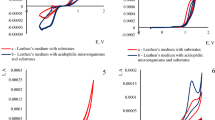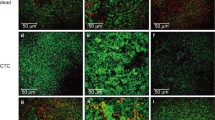Abstract
The growth of Thiobacillus (T.) intermedius strain K12 and Thiobacillus versutus strain DSM 582 on thiosulfate and tetrathionate was studied combining on-line measurements of metabolic activity and sulfur compound analysis. Most results indicate that T. intermedius oxidized thiosulfate via tetrathionate to sulfate. Concomittantly, sulfur compound intermediates like triand pentathionate were detectable. The formation is probably the result of highly reactive sulfane monosulfonic acids. The formation of tetrathionate allows the cells to buffer temporarily the proton excretion from sulfuric acid production. With T. versutus intermediate sulfur compounds were not detectable, however, sulfur was detectable. The possibility of a thiosulfate oxidation via dithionate, S2O sup2-inf6 , is discussed. The on-line measurement of metabolic activity by microcalorimetry enabled us to detect that cells of T. intermedius adhere to surfaces and produce a biofilm by a metabolic process whereas those of T. versutus fail to do so. The importance of the finding is discussed.
Similar content being viewed by others
References
BelaichJP (1980) Growth and metabolism in bacteria. In: BeezerAE (ed) Biological microcalorimetry. Academic Press, London, pp 1–42
BradfordMM (1976) A rapid and sensitive method for the quantitation of microgram quantities of protein, utilizing the principle of protein-dye binding. Ann Biochem 72: 248–254
CerlettiP (1986) Seeking a better job for an under-employed enzyme, rhodanese. Trends Biochem Sci 11: 369–372
CharlesAM, SuzukiI (1966) Mechanism of thiosulfate oxidation by Thiobacillus novellus. Biochim Biophys Acta 128: 510–521
EmmelT, SandW, KönigWA, BockE (1986) Evidence for the existence of a sulfur oxygenase in Sulfolobus brierleyi. J Gen Microbiol 132: 3415–3420
FehérF (1975) Scltwefel, Selen, Tellur. In: BrauerG (ed) Handbuch der Präparativen Anorganischen Chemie, part I 2nd edn. Enke, Stuttgart, p 356
Flemming HC (1992) Biofilme, Biofouling und Mikrobielle Schädigung von Werkstoffen. Habilitation thesis, Universität Stuttgart
Gmelin (1960) Handbuch der Anorganischen Chemie, 8. Aufl. Schwefel, Teil B2. Verlag Chemie, Weinheim, pp 969–1046
GoodmanA, RalphBJ (1980) A microcalorimetric study of the metabolic activity of two thiobacillus species. In: TrudingerPA, WalterMR, RalphBJ (eds) Biogeochemistry of ancient and modern environments. Springer, Berlin Heidelberg New York pp 477–483
GustafssonL, NorkransB (1976) On the mechanism of salt tolerance. Arch Microbiol 110: 177–183
Harrison jr AP (1983) Genomic and physiological comparison between heterotrophic thiobacilli and Acdiphilium cryptum, Thiobacillus versutus sp. nov., and Thiobacillus acidophilus nom rev. Int J Syst Bacteriol 33: 211–217
HumphreyAB, MarshallKC (1984) The triggering effect of surfaces and surfactants on heat output, oxygen consumption and size reduction of a starving marine Vibrio. Arch Microbiol 140: 166–170
KellyDP (1989) Physiology and biochemistry of unicellular sulfur bacteria. In: SchlegelHG, BowienB (eds) Autotrophic bacteria. Science Tech Publ, Madison Ill., pp 193–218
KlimmekO, KrögerA, SteudelR, HoldtG (1991) Growth of Wolinella succinogenes with polysulfide as terminal acceptor of phosphorylative electron transport. Arch Microbiol 155: 177–182
LuW-P (1986) A periplasmic location for the thiosulfate-oxidizing multienzyme system from Thiobacillus versutus. FEMS Microbiol Lett 34: 313–317
LuW-P, KellyDP (1988) Cellular location and partial purification of the thiosulphate-oxidizing enzyme and trithionate hydrolase from Thiobacillus tepidarius. J Gen Microbiol 134: 877–885
LuW-P, SwobodaBEP, KellyDP (1985) Properties of the thiosulphate-oxidizing multienzyme system from Thiobacillus versutus. Biochim Biophys Acta 828: 116–122
MarshallKC (1992) Biofilms: an overview of bacterial adhesion, activity and control at surfaces. ASM News 58: 202–207
MeulenbergR, PronkJT, FrankJ, HazeuW, BosP, KuenenJG (1992) Purification and partial characterization of a thermostable trithionate hydrolase from the acidophilic sulphur oxidizer Thiobacillus acidophilus. Eur J Biochem 209: 367–374; Personal communication to R.S.
MildeK, SandW, WolffW, BockE (1983) Thiobacilli of the corroded concrete walls of the Hamburg sewer system. J Gen Microbiol 129: 1327–1333
OhJK, SuzukiI (1977) Isolation and characterization of a membrane-associated thiosulfate-oxidizing system of Thiobacillus novellus. J Gen Microbiol 99: 397–412
Okuzumim, KitaY (1965) Studies on biochemistry of the thiobacilli, part VI. Oxidation of thiosulfate to tetrathionate by T. thiooxidans. Agric Biol Chem 29: 1063–1068
OsNMvan, HaandrikmanG (1987) Liquid-flow microcalorimetry of surfactant adsorption onto sandstone. 1. Experimental method and initial results. Langmuir 3: 1051–1056
Perkin-Elmer (1988) Gerätehandbuch für das Atomabsorptions-Spektrometer 1100B. Technische Dokumentation, Überlingen, Germany
PooleRK, HaddockBA (1975) Microcalorimetric measurements of heat evolution and their correlation with oxygen uptake in Escherichia coli genotypically and phenotypically modified transport chains. FEBS Lett 58: 249–253
PronkJT, MeulenbergR, HazeuW, BosP, KuenenJG (1990) Oxidation of reduced inorganic sulphur compounds by acidophilic thiobacillis. FEMS Microbiol Rev 75: 293–306
SandW (1987) Mikrokalorimetrie — ein modernes Meßverfahren für biologische Frangestellungen. Forum Mikrobiol 10: 220–223
SchröterAW, SandW (1988) Microcalorimetry — a modern technique for microbiology and biohydrometallurgy: In: NorrisPR, KellyDP (eds) Biohydrometallurgy. Science and Technology Letters, Kew, pp 127–133
SchröterAW, SandW (1989) Investigation on leaching bacteria by microcalorimetry: In: SalleyJ, McCreadyR, WichlaczPC (eds) Biohydrometallurgy. CANMET, Ottawa, pp 427–438
SchröterAW, SandW (1993) Estimations on the degradability of ores and bacterial leaching activity using short-time microcalorimetric tests. FEMS Microbiol Rev 11: 79–86
SinhaDB, WaldenCC (1966) Formation of polythionates and their interrelationships during oxidation of thiosulfate by Thiobacillus ferrooxidans. Can J Microbiol 12: 1041–1054
SpectorT (1978) Refinement of Coomassie-blue method of protein quantitation. Ann Biochem 86: 142–146
SteudelR, AlbertsenA (1992) Determination of cystein-S-sulfonate (RSSO sup-inf3 ) by ion-pair chromatography and its formation by autoxidation of cysteine persulfide (RSS-). J Chromatogr 606: 260–263
SteudelR, MäusleH-J, RosenbauerD, MöckelH, FreyholdtT (1981) Separation and determination of homocyclic sulfur molecules by high pressure liquid chromatography — detection of new sulfur rings. Angew Chem 93: 402–404 [Angew Chem Int Ed Engl 20: 394–395]
SteudelR, HoldtG, GöbelT, HazeuW (1987) Chromatographic separation of higher polythionates SnO sup2-inf6 (n=3...22) and their detection in cultures of Thiobacillus ferrooxidans; molecular composition of bacterial sulfur excretions. Angew Chem 99: 143–146 [Angew Chem Int Ed Engl 26: 151–153]
SteudelR, HoldtG, VisscherPT, GemerdenHvan (1990) Search for polythionates in cultures of Chromatium vinosum after sulfide incubation. Arch Microbiol 153: 432–437
TrudingerPA (1967) The metabolism of inorganic sulphur compounds by thiobacilli. Rev Pure Appl Chem 17: 1–24
VishniacWV, SanterM (1957) The thiobacilli. Bacteriol Rev. 21: 195–610
Author information
Authors and Affiliations
Rights and permissions
About this article
Cite this article
Wentzien, S., Sand, W., Albertsen, A. et al. Thiosulfate and tetrathionate degradation as well as biofilm generation by Thiobacillus intermedius and Thiobacillus versutus studied by microcalorimetry, HPLC, and ion-pair chromatography. Arch. Microbiol. 161, 116–125 (1994). https://doi.org/10.1007/BF00276471
Received:
Accepted:
Issue Date:
DOI: https://doi.org/10.1007/BF00276471




